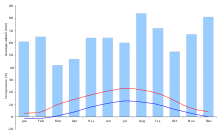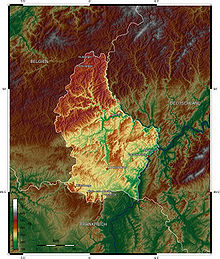Luxembourg
![]()
The title of this article is ambiguous. For other meanings, see Luxembourg (disambiguation).
The Grand Duchy of Luxembourg (Luxembourgish Groussherzogtum Lëtzebuerg [ˈgʀəʊsˌhɛχtsoːktuːm ˈlətsəbuəɕ], French Grand-Duché de Luxembourg [ɡʁɑ̃ dyʃe də lyksɑ̃buʁ]) is a democratic state in the form of a parliamentary monarchy in west-central Europe. The country had a population of about 630,000 at the end of 2019. The Grand Duchy belongs to the Central German-speaking region. The national language is Luxembourgish; additional administrative and official languages are Standard German and French.
Historically, Luxembourg belonged to the Holy Roman Empire and the German Confederation. In the course of the Luxembourg Crisis, the Second Treaty of London in 1867 with a stipulation of Luxembourg's neutrality led to its withdrawal from the association of German states. Until 1890, the Grand Duchy was ruled in personal union by the Dutch king and occupied by the German Empire during the two World Wars. It subsequently took a leading role in European integration after the Second World War and became a founding member of NATO, the UN and the European Union.
Together with its neighbouring state Belgium and the Netherlands, Luxembourg forms the Benelux countries. Together with the Saarland, the French region of Lorraine as well as the Walloon region in Belgium and the German state of Rhineland-Palatinate, it belongs to the "Greater Region (Saar-Lor-Lux)", which is home to around 11.6 million people. The region records the highest cross-border mobility of workers within the European Union.
Country name
The name Luxembourg is probably derived from the name of the castle Lucilinburhuc, later Lützelburg ("lützel" = "small"; cf. Low German and Frisian "lütt", English "little"), the "Little Castle", which was built in 963 for Siegfried, the then Count of the Ardennes, as his ancestral seat, and around which the (main) city of Luxembourg of the same name developed. The name Lucilinburhuc, in turn, is said to originate from the word "Letze", which denotes a fortified rocky outcrop. In fact, the ancestral castle is located on a rocky spur, the so-called Bockfelsen.
The land originated as a county in the Holy Roman Empire of the German Nation. In German-speaking areas, the name Lützenburg or Lützelburg was still used in the 17th century, for example in the Topographia of Matthäus Merian. Later this name was replaced by Luxembourg, which is nothing else than the Germanized French form of the name Luxembourg. In 1354 the county of Luxembourg became a duchy. At the Congress of Vienna in 1815, the Duchy of Luxembourg was elevated to a Grand Duchy; William I of Nassau-Orania, King of the United Netherlands, became the first Grand Duke in personal union. The personal union ended in 1890 with the accession to power of the present dynasty of Luxembourg-Nassau, which was officially called Nassau-Weilburg until 1964. In the meantime, the country is the last grand duchy.
Geography
Geographical location
Luxembourg borders France for 73 kilometres to the south, Belgium for 148 kilometres to the west and Germany for 135 kilometres to the east. The north of the country is part of the Ardennes and is called (the) Ösling. This part lies at an average of 400 to 500 metres above sea level. The landscape in the Ösling is characterized by forested mountains, hills and deep river valleys, for example the valley of the Sauer. At 560 metres, the "Kneiff" hill in Huldingen is the highest elevation in the country. In the north of Luxembourg, 358 square kilometres of the country are protected by the German-Luxembourg Nature Park.
Structure
To the south lies the fertile Gutland, which is part of the Lorraine Stepped Land. This area has a higher population and industrial density than the Ösling. The land is drained by the Sûre, which runs to the west-east, with the Klerf and Our to the north and the Alzette to the south. The lowest point of the land, called Spatz (129 m), is at the confluence of the Sûre and Moselle rivers in Wasserbillig.
Rivers
Important rivers in Luxembourg are the Moselle, which forms the border river with Germany in the southeast, the Sauer, the Our and the Alzette.
See also: List of rivers in Luxembourg
Climate
Luxembourg has a temperate Central European climate, influenced by Atlantic sea winds and characterised by mild winters and temperate and therefore pleasant summers. The air is mostly mild and humid; the annual rainfall is 782.2 mm; annual mean temperatures are 9 °C, 0.8 °C in January, 17.5 °C in July. Thus, the average temperatures recorded in January, the coldest month, are about 2 °C. The highest temperatures are usually measured during the summer months of July and August. At this time, the average temperature is about 15 to 25 °C. In the north of the country, the Ösling, it is usually a little cooler and precipitation is also more frequent.
flora and fauna
The Ösling in the north of the country, part of the Ardennes, is characterised by forested low mountain ranges and deep river valleys. The most widespread tree species are copper beech, oak, maple and spruce. Oak coppices, the so-called Lohhecken, still occupy a large part of the forest area. Unwooded areas are characterised by bell heather and holly, among others. The labiates true and bunch-hamander are Mediterranean plants that occur in the southeast of Luxembourg. There is a diversity of grassland types; however, the extensively used species-rich rough grasslands are declining (20% of the surveyed grassland species are on the Red List of vascular plants of Luxembourg). The vegetation of the lower-lying southern part of the country (approx. 300 m), in the so-called Gutland, is characterised by agricultural use and viticulture along the Moselle.
The spruce forests of Luxembourg, which cover 30 % of the country's forested area, are considered to be unnatural. They are the result of the afforestation of coppice forests and unprofitable areas with this fast-growing species, which became fashionable after the Second World War. However, with the exception of Scots pine, all conifers in Luxembourg are outside their natural ranges.
The fauna corresponds to the usual fauna for Central European countries. However, the Ösling impresses with large populations of red and wild boar as well as birds of prey and rare bird species such as the black stork or the hazel grouse. Other species, on the other hand, are showing a marked decline in numbers. In the 1960s, for example, the Little Owl numbered between 3400 and 4200 breeding pairs in Luxembourg. In 2006, the population had declined to 15 to 20 breeding pairs. Luxembourg is known for its abundance of fish, there are trout, pike, pikeperch, eels, carp and many other fish species. Especially in the mild Moselle valley, but also in many other places (e.g. along railway lines), the wall lizard has settled, an animal usually found in Mediterranean countries.
Hunting in Luxembourg is inextricably linked to land ownership and is organised in a territorial hunting system. The most important game in terms of value of the game and the damage caused by game in the forest and in the fields are roe deer and wild boar. Other game species relevant to hunting include red deer, mallard and brown hare.
54.8% of mammal species, 41.5% of bird species, 33% of reptile species, 71.4% of amphibians and 62% of fish species in Luxembourg are threatened. This is according to the Observatoire de l'Environnement Naturel (OEN), which has updated the Plan National Protection Nature.
There are a number of planned or already implemented nature conservation projects: for example the Bongert Altenhoven, the semi-arid grasslands near Junglinster, the Deiwelskopp nature trail, the Neibruch near Grosbous, the Prënzebierg nature reserve, the Sonnebierg nature reserve, the Canecher Wéngertsbierg or the Cornelysmillen wetland.

Climate diagram of Luxembourg City
,_Schiessentümpel_--_2015_--_6022.jpg)
The shooting pond in Müllerthal

Relief map
Questions and Answers
Q: Where is Luxembourg located?
A: Luxembourg is located in Western Europe.
Q: What is the official name of Luxembourg?
A: The official name of Luxembourg is the Grand Duchy of Luxembourg.
Q: What are the official languages of Luxembourg?
A: The official languages of Luxembourg are Luxembourgish, French, and German.
Q: Which countries are next to Luxembourg?
A: The countries next to Luxembourg are Belgium, Germany, and France.
Q: When did Luxembourg join the European Union?
A: Luxembourg was one of the first countries to join the European Union.
Q: What is the population of Luxembourg as of 2015?
A: As of 2015, the population of Luxembourg was 569,700, making it one of Europe's most densely populated countries.
Q: What is the Benelux?
A: The Benelux is a political and economic union between Belgium, the Netherlands, and Luxembourg.
Search within the encyclopedia